Linear Segmented Arc-Shaped Piezoelectric Branch Beam Energy Harvester for Ultra-Low Frequency Vibrations
Abstract
:1. Introduction
2. Design of Arc-Shaped Branch Beam Harvester
3. Finite Element Analysis (FEA)
3.1. Geometrical Optimisation of the ASBBH—Parametric Study
3.2. Static Analysis
3.2.1. Tip Deflection
3.2.2. Highest Stress and Strain
3.3. Modal Analysis and Mode Shapes
3.3.1. Modal Analysis
3.3.2. Mode Shapes of ASBBH
4. Experimental Study
4.1. Stage 1: Shaker Test
4.2. Stage 2: Human Motion Test
| Reference | Human Motion Type | Frequency Range of Interest (Hz) |
|---|---|---|
| Kumar, Anuruddh, et al. [45] | Hear beat | 1–1.5 |
| Dong, Lin, et al. [46] | Lung motion | 0.2–0.5 |
| Kim, Jae Woo, et al. [47] | Finger-triggering | 0.5–5 |
| Maharjan, Pukar, et al. [62] | Hand shake | 0.5–6 |
| Cai, Mingjing, et al. [48] | Walking | 0.5–2 |
| Cavagna, G. A., et al. [49] | Running | 1–5 |
5. Results and Discussion
5.1. Shaker Test
5.1.1. Output Voltage
5.1.2. Idle Time
5.1.3. Operating Bandwidth
5.1.4. Voltage Generation at Different Natural Frequencies of ASBBH
5.1.5. Harvested Power
5.2. Human Motion
5.2.1. Output Voltage
5.2.2. Harvested Power
5.2.3. Average Output Power
5.2.4. Performance Comparison with Existing Designs
6. Conclusions
Supplementary Materials
Author Contributions
Funding
Institutional Review Board Statement
Informed Consent Statement
Data Availability Statement
Acknowledgments
Conflicts of Interest
References
- Li, S.; Xu, L.D.; Zhao, S. The internet of things: A survey. Inf. Syst. Front. 2015, 17, 243–259. [Google Scholar] [CrossRef]
- Shi, B.; Li, Z.; Fan, Y. Implantable energy-harvesting devices. Adv. Mater. 2018, 30, 1801511. [Google Scholar] [CrossRef]
- Maamer, B.; Boughamoura, A.; El-Bab, A.M.F.; Francis, L.A.; Tounsi, F. A review on design improvements and techniques for mechanical energy harvesting using piezoelectric and electromagnetic schemes. Energy Convers. Manag. 2019, 199, 111973. [Google Scholar] [CrossRef]
- Sobianin, I.; Psoma, S.; Johnson, J.; Jowers, I.; Tourlidakis, A. A hybrid piezoelectric and electrostatic energy harvester for scavenging arterial pulsations. Mater. Today Proc. 2022. [Google Scholar] [CrossRef]
- Li, M.; Luo, A.; Luo, W.; Wang, F. Recent Progress on Mechanical Optimization of MEMS Electret-Based Electrostatic Vibration Energy Harvesters. J. Microelectromech. Syst. 2022, 31, 726–740. [Google Scholar] [CrossRef]
- Wang, S.; Miao, G.; Zhou, S.; Yang, Z.; Yurchenko, D. A novel electromagnetic energy harvester based on the bending of the sole. Appl. Energy 2022, 314, 119000. [Google Scholar] [CrossRef]
- Muscat, A.; Bhattacharya, S.; Zhu, Y. Electromagnetic vibrational energy harvesters: A review. Sensors 2022, 22, 5555. [Google Scholar] [CrossRef]
- Haroun, A.; Tarek, M.; Mosleh, M.; Ismail, F. Recent Progress on Triboelectric Nanogenerators for Vibration Energy Harvesting and Vibration Sensing. Nanomaterials 2022, 12, 2960. [Google Scholar] [CrossRef]
- Wang, R.; Ji, M.; Jin, X.; Zhang, Q.; Jiao, T. Recent Developments in Functional Triboelectric Nanogenerator for Flame Retardant, Human Health and Energy Harvesting: A Crucial Review. Nano Futures 2022, 6, 022003. [Google Scholar] [CrossRef]
- Zheng, X.; He, L.; Wang, S.; Liu, X.; Liu, R.; Cheng, G. A review of piezoelectric energy harvesters for harvesting wind energy. Sens. Actuators A Phys. 2023, 352, 114190. [Google Scholar] [CrossRef]
- Erturk, A.; Inman, D.J. Piezoelectric Energy Harvesting; John Wiley & Sons: Hoboken, NJ, USA, 2011. [Google Scholar]
- Izadgoshasb, I.; Lim, Y.Y.; Lake, N.; Tang, L.; Padilla, R.V.; Kashiwao, T. Optimizing orientation of piezoelectric cantilever beam for harvesting energy from human walking. Energy Convers. Manag. 2018, 161, 66–73. [Google Scholar] [CrossRef]
- Kargar, S.M.; Hao, G. An Atlas of Piezoelectric Energy Harvesters in Oceanic Applications. Sensors 2022, 22, 1949. [Google Scholar] [CrossRef] [PubMed]
- Sheng, W.; Xiang, H.; Zhang, Z.; Yuan, X. High-efficiency piezoelectric energy harvester for vehicle-induced bridge vibrations: Theory and experiment. Compos. Struct. 2022, 299, 116040. [Google Scholar] [CrossRef]
- Hariyanto, M.; Mayantasari, M.; Robiandi, F. Design of Micro Power Energy Harvesting by Using High-Powered Engine Noise (Case Study: Generator Set ITK). J. Phys. Conf. Ser. 2022, 2243, 012042. [Google Scholar] [CrossRef]
- Kumar, A.; Kumar, R.; Jain, S.C.; Vaish, R. Vibration induced refrigeration and energy harvesting using piezoelectric materials: A finite element study. RSC Adv. 2019, 9, 3918–3926. [Google Scholar] [CrossRef]
- Lim, Y.Y.; Soh, C.K. Towards more accurate numerical modeling of impedance based high frequency harmonic vibration. Smart Mater. Struct. 2014, 23, 035017. [Google Scholar] [CrossRef]
- Tang, Z.S.; Lim, Y.Y.; Smith, S.T.; Padilla, R.V. Modelling of the electromechanical impedance technique for prediction of elastic modulus of structural adhesives. Struct. Health Monit. 2020, 1475921720916924. [Google Scholar] [CrossRef]
- Lim, Y.Y.; Soh, C.K. Effect of varying axial load under fixed boundary condition on admittance signatures of electromechanical impedance technique. J. Intell. Mater. Syst. Struct. 2012, 23, 815–826. [Google Scholar] [CrossRef]
- Khalid, S.; Raouf, I.; Khan, A.; Kim, N.; Kim, H.S. A review of human-powered energy harvesting for smart electronics: Recent progress and challenges. Int. J. Precis. Eng. Manuf. Green Technol. 2019, 6, 821–851. [Google Scholar] [CrossRef]
- Izadgoshasb, I. Performance Enhancement of Human Motion Based Piezoelectric Energy Harvesters. Ph.D. Thesis, Southern Cross University, Lismore, Australia, 2019. [Google Scholar]
- Erturk, A.; Inman, D.J. A distributed parameter electromechanical model for cantilevered piezoelectric energy harvesters. J. Vib. Acoust. 2008, 130, 041002. [Google Scholar] [CrossRef]
- Pillatsch, P.; Yeatman, E.M.; Holmes, A.S. A piezoelectric frequency up-converting energy harvester with rotating proof mass for human body applications. Sens. Actuators A Phys. 2014, 206, 178–185. [Google Scholar] [CrossRef]
- Shukla, R.; Bell, A.J. PENDEXE: A novel energy harvesting concept for low frequency human waistline. Sens. Actuators A Phys. 2015, 222, 39–47. [Google Scholar] [CrossRef]
- Fan, K.; Yu, B.; Zhu, Y.; Liu, Z.; Wang, L. Scavenging energy from the motion of human lower limbs via a piezoelectric energy harvester. Int. J. Mod. Phys. B 2017, 31, 1741011. [Google Scholar] [CrossRef]
- Pozzi, M.; Aung, M.S.; Zhu, M.; Jones, R.K.; Goulermas, J.Y. The pizzicato knee-joint energy harvester: Characterization with biomechanical data and the effect of backpack load. Smart Mater. Struct. 2012, 21, 075023. [Google Scholar] [CrossRef]
- Izadgoshasb, I.; Lim, Y.Y.; Tang, L.; Padilla, R.V.; Tang, Z.S.; Sedighi, M. Improving efficiency of piezoelectric based energy harvesting from human motions using double pendulum system. Energy Convers. Manag. 2019, 184, 559–570. [Google Scholar] [CrossRef]
- Fan, K.; Liu, S.; Liu, H.; Zhu, Y.; Wang, W.; Zhang, D. Scavenging energy from ultra-low frequency mechanical excitations through a bi-directional hybrid energy harvester. Appl. Energy 2018, 216, 8–20. [Google Scholar] [CrossRef]
- Zhang, G.; Hu, J. A branched beam-based vibration energy harvester. J. Electron. Mater. 2014, 43, 3912–3921. [Google Scholar] [CrossRef]
- Upadrashta, D.; Yang, Y. Trident-shaped multimodal piezoelectric energy harvester. J. Aerosp. Eng. 2018, 31, 04018070. [Google Scholar] [CrossRef]
- Izadgoshasb, I.; Lim, Y.Y.; Vasquez Padilla, R.; Sedighi, M.; Novak, J.P. Performance enhancement of a multiresonant piezoelectric energy harvester for low frequency vibrations. Energies 2019, 12, 2770. [Google Scholar] [CrossRef]
- Piyarathna, I.E.; Lim, Y.Y.; Edla, M.; Thabet, A.M.; Ucgul, M.; Lemckert, C. Enhancing the Bandwidth and Energy Production of Piezoelectric Energy Harvester Using Novel Multimode Bent Branched Beam Design for Human Motion Application. Sensors 2023, 23, 1372. [Google Scholar] [CrossRef]
- Yang, Z.; Wang, Y.Q.; Zuo, L.; Zu, J. Introducing arc-shaped piezoelectric elements into energy harvesters. Energy Convers. Manag. 2017, 148, 260–266. [Google Scholar] [CrossRef]
- Yang, Z.; Zu, J. Comparison of PZN-PT, PMN-PT single crystals and PZT ceramic for vibration energy harvesting. Energy Convers. Manag. 2016, 122, 321–329. [Google Scholar] [CrossRef]
- Lee, G.; Shin, D.-J.; Kwon, Y.-H.; Jeong, S.-J.; Koh, J.-H. Optimized piezoelectric and structural properties of (Bi, Na) TiO3–(Bi,K)TiO3 ceramics for energy harvester applications. Ceram. Int. 2016, 42, 14355–14363. [Google Scholar] [CrossRef]
- Guyomar, D.; Badel, A.; Lefeuvre, E.; Richard, C. Toward energy harvesting using active materials and conversion improvement by nonlinear processing. IEEE Trans. Ultrason. Ferroelectr. Freq. Control. 2005, 52, 584–595. [Google Scholar] [CrossRef]
- Mitcheson, P.D.; Burrow, S.G.; Briand, D.; Yeatman, E.; Roundy, S. Power Conditioning for Energy Harvesting–Case Studies and Commercial Products. In Micro Energy Harvesting; Wiley-VCH Verlag GmbH & Co. KgaA: Weinheim, Germany, 2015; pp. 385–400. [Google Scholar]
- Lallart, M. Nonlinear technique and self-powered circuit for efficient piezoelectric energy harvesting under unloaded cases. Energy Convers. Manag. 2017, 133, 444–457. [Google Scholar] [CrossRef]
- Muthalif, A.G.; Nordin, N.D. Optimal piezoelectric beam shape for single and broadband vibration energy harvesting: Modeling, simulation and experimental results. Mech. Syst. Signal Process. 2015, 54, 417–426. [Google Scholar] [CrossRef]
- Baker, J.; Roundy, S.; Wright, P. Alternative geometries for increasing power density in vibration energy scavenging for wireless sensor networks. In Proceedings of the 3rd International Energy Conversion Engineering Conference, Changsha, China, 22–24 April 2022; p. 5617. [Google Scholar]
- Hu, H.; Xue, H.; Hu, Y. A spiral-shaped harvester with an improved harvesting element and an adaptive storage circuit. IEEE Trans. Ultrason. Ferroelectr. Freq. Control. 2007, 54, 1177–1187. [Google Scholar] [CrossRef]
- Amin Karami, M.; Inman, D.J. Powering pacemakers from heartbeat vibrations using linear and nonlinear energy harvesters. Appl. Phys. Lett. 2012, 100, 042901. [Google Scholar] [CrossRef]
- Zhang, H.; Sui, W.; Yang, C.; Zhang, L.; Song, R.; Wang, J. An asymmetric magnetic-coupled bending-torsion piezoelectric energy harvester: Modeling and experimental investigation. Smart Mater. Struct. 2021, 31, 015037. [Google Scholar] [CrossRef]
- Kathpalia, B.; Tan, D.; Stern, I.; Erturk, A. An experimentally validated model for geometrically nonlinear plucking-based frequency up-conversion in energy harvesting. Smart Mater. Struct. 2017, 27, 015024. [Google Scholar] [CrossRef]
- Kumar, A.; Kiran, R.; Kumar, S.; Chauhan, V.S.; Kumar, R.; Vaish, R. A comparative numerical study on piezoelectric energy harvester for self-powered pacemaker application. Glob. Chall. 2018, 2, 1700084. [Google Scholar] [CrossRef]
- Dong, L.; Closson, A.B.; Jin, C.; Trase, I.; Chen, Z.; Zhang, J.X. Vibration-Energy-Harvesting System: Transduction Mechanisms, Frequency Tuning Techniques, and Biomechanical Applications. Adv. Mater. Technol. 2019, 4, 1900177. [Google Scholar] [CrossRef] [PubMed]
- Kim, J.W.; Salauddin, M.; Cho, H.; Rasel, M.S.; Park, J.Y. Electromagnetic energy harvester based on a finger trigger rotational gear module and an array of disc Halbach magnets. Appl. Energy 2019, 250, 776–785. [Google Scholar] [CrossRef]
- Cai, M.; Yang, Z.; Cao, J.; Liao, W.-H. Recent advances in human motion excited energy harvesting systems for wearables. Energy Technol. 2020, 8, 2000533. [Google Scholar] [CrossRef]
- Cavagna, G.; Willems, P.; Franzetti, P.; Detrembleur, C. The two power limits conditioning step frequency in human running. J. Physiol. 1991, 437, 95–108. [Google Scholar] [CrossRef]
- Prilutsky, B.I.; Zatsiorsky, V.M. Tendon action of two-joint muscles: Transfer of mechanical energy between joints during jumping, landing, and running. J. Biomech. 1994, 27, 25–34. [Google Scholar] [CrossRef]
- Novacheck, T.F. The biomechanics of running. Gait Posture 1998, 7, 77–95. [Google Scholar] [CrossRef]
- Yang, Z.; Zhou, S.; Zu, J.; Inman, D. High-performance piezoelectric energy harvesters and their applications. Joule 2018, 2, 642–697. [Google Scholar] [CrossRef]
- Antonsson, E.K.; Mann, R.W. The frequency content of gait. J. Biomech. 1985, 18, 39–47. [Google Scholar] [CrossRef]
- Helbing, D.; Johansson, A. Pedestrian, crowd, and evacuation dynamics. arXiv 2013, arXiv:1309.1609. [Google Scholar]
- Griffin, M.J. Vibration and Motion. In Handbook of Human Factors and Ergonomics; John Wiley & Sons: Hoboken, NJ, USA, 2012; pp. 828–857. [Google Scholar]
- Abbate, S.; Avvenuti, M.; Corsini, P.; Light, J.; Vecchio, A. Monitoring of human movements for fall detection and activities recognition in elderly care using wireless sensor network: A survey. In Wireless Sensor Networks: Application-Centric Design; IntechOpen: Rijeka, Croatia, 2010; Volume 1. [Google Scholar]
- Southgate, D.; Childs, P.; Bull, A. Sports Innovation, Technology and Research; World Scientific: Singapore, 2016. [Google Scholar]
- Li, W.G.; He, S.; Yu, S. Improving power density of a cantilever piezoelectric power harvester through a curved L-shaped proof mass. IEEE Trans. Ind. Electron. 2009, 57, 868–876. [Google Scholar] [CrossRef]
- Camilloni, E.; DeMaso-Gentile, G.; Scavongelli, C.; Orcioni, S.; Conti, M. Piezoelectric Energy Harvesting on Running Shoes. In Mobile Networks for Biometric Data Analysis; Springer: Berlin, Germany, 2016; pp. 91–107. [Google Scholar]
- Wei, S.; Hu, H.; He, S. Modeling and experimental investigation of an impact-driven piezoelectric energy harvester from human motion. Smart Mater. Struct. 2013, 22, 105020. [Google Scholar] [CrossRef]
- Moro, L.; Benasciutti, D. Harvested power and sensitivity analysis of vibrating shoe-mounted piezoelectric cantilevers. Smart Mater. Struct. 2010, 19, 115011. [Google Scholar] [CrossRef]
- Maharjan, P.; Bhatta, T.; Rasel, M.S.; Salauddin, M.; Rahman, M.T.; Park, J.Y. High-performance cycloid inspired wearable electromagnetic energy harvester for scavenging human motion energy. Appl. Energy 2019, 256, 113987. [Google Scholar] [CrossRef]
- Edla, M.; Lim, Y.Y.; Deguchi, M.; Padilla, R.V. A Novel Discontinuous Mode Piezoelectric Energy Harvesting Circuit for Low-Voltage Applications. In Proceedings of the 2021 31st Australasian Universities Power Engineering Conference (AUPEC), Virtual, 26–30 September 2021; pp. 1–5. [Google Scholar]
- Edla, M.; Lim, Y.Y.; Vasquez Padilla, R.; Deguchi, M. An Improved Rectifier Circuit for Piezoelectric Energy Harvesting from Human Motion. Appl. Sci. 2021, 11, 2008. [Google Scholar] [CrossRef]
- Edla, M.; Lim, Y.Y.; Deguchi, M.; Padilla, R.V.; Izadgoshasb, I. An improved self-Powered H-bridge circuit for voltage rectification of piezoelectric energy harvesting system. IEEE J. Electron Devices Soc. 2020, 8, 1050–1062. [Google Scholar] [CrossRef]
- Jiang, W.; Wang, L.; Zhao, L.; Luo, G.; Yang, P.; Ning, S.; Lu, D.; Lin, Q. Modeling and design of V-shaped piezoelectric vibration energy harvester with stopper for low-frequency broadband and shock excitation. Sens. Actuators A Phys. 2021, 317, 112458. [Google Scholar] [CrossRef]
- Nastro, A.; Pienazza, N.; Baù, M.; Aceti, P.; Rouvala, M.; Ardito, R.; Ferrari, M.; Corigliano, A.; Ferrari, V. Wearable Ball-Impact Piezoelectric Multi-Converters for Low-Frequency Energy Harvesting from Human Motion. Sensors 2022, 22, 772. [Google Scholar] [CrossRef]






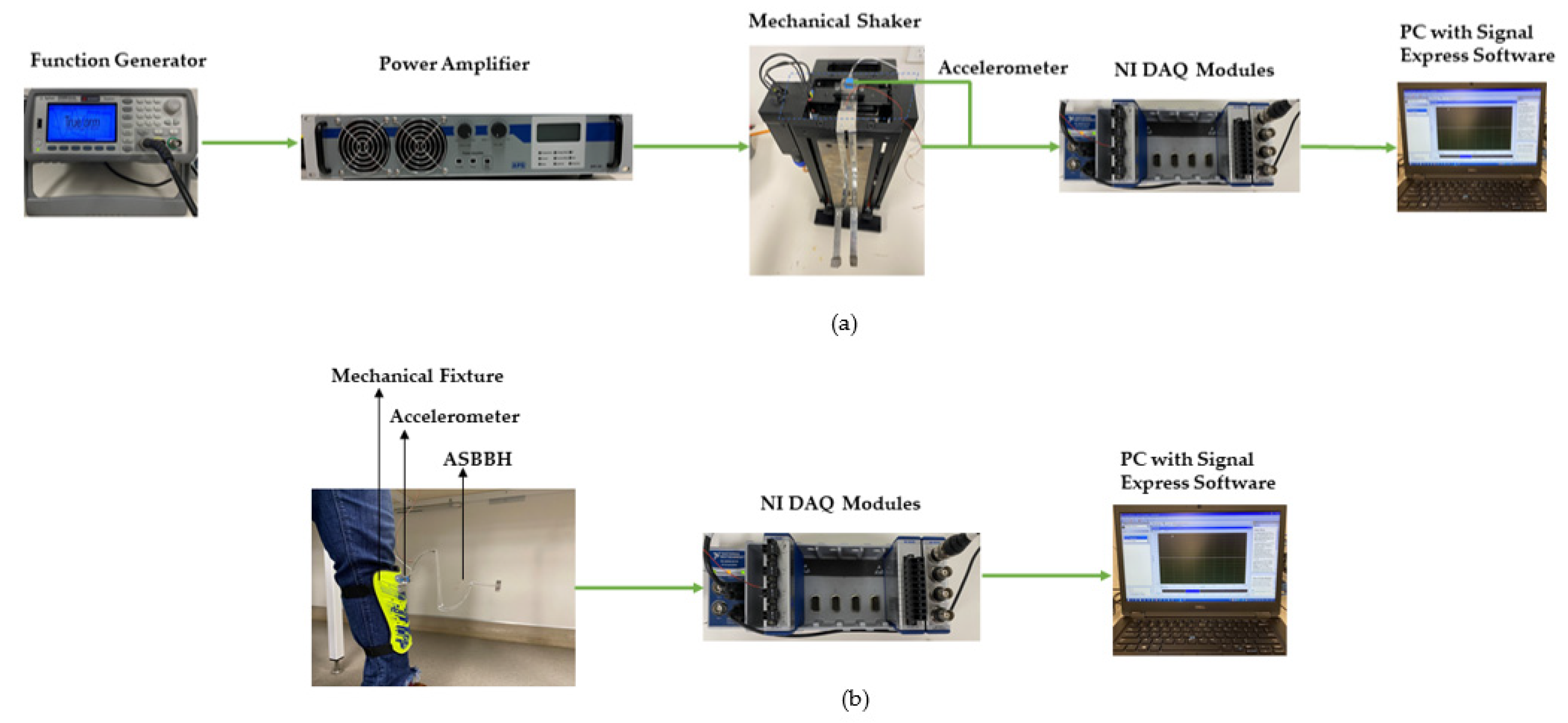

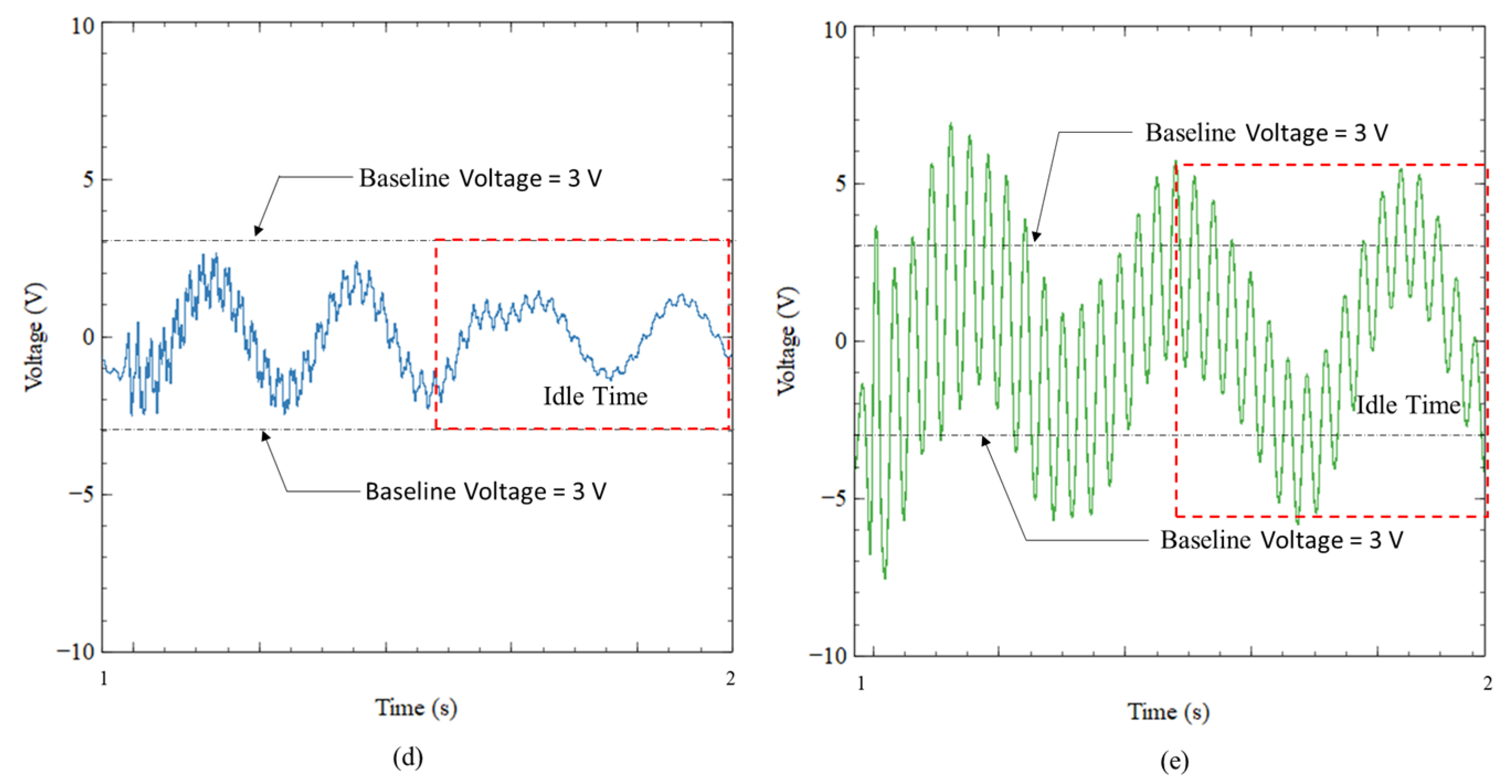
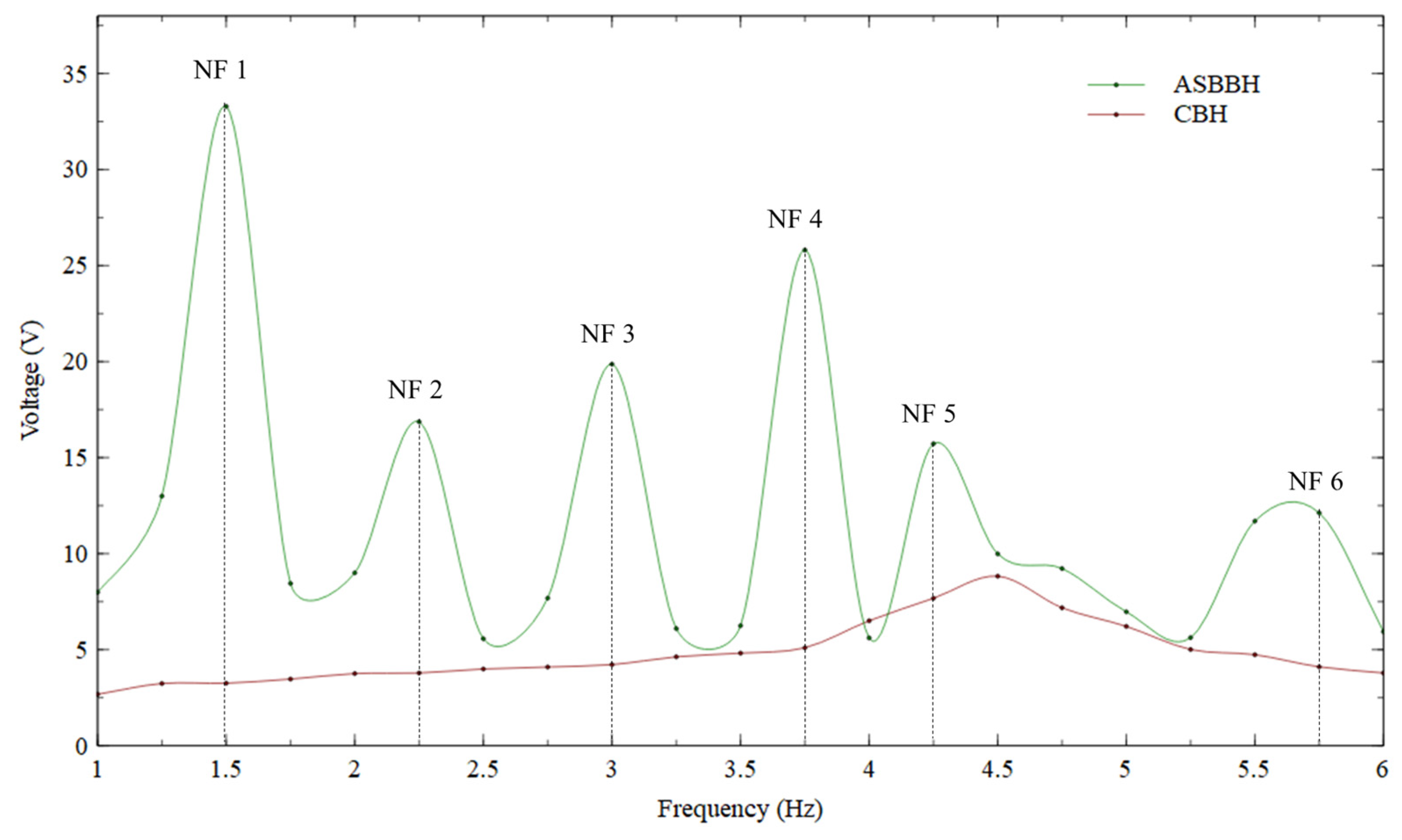
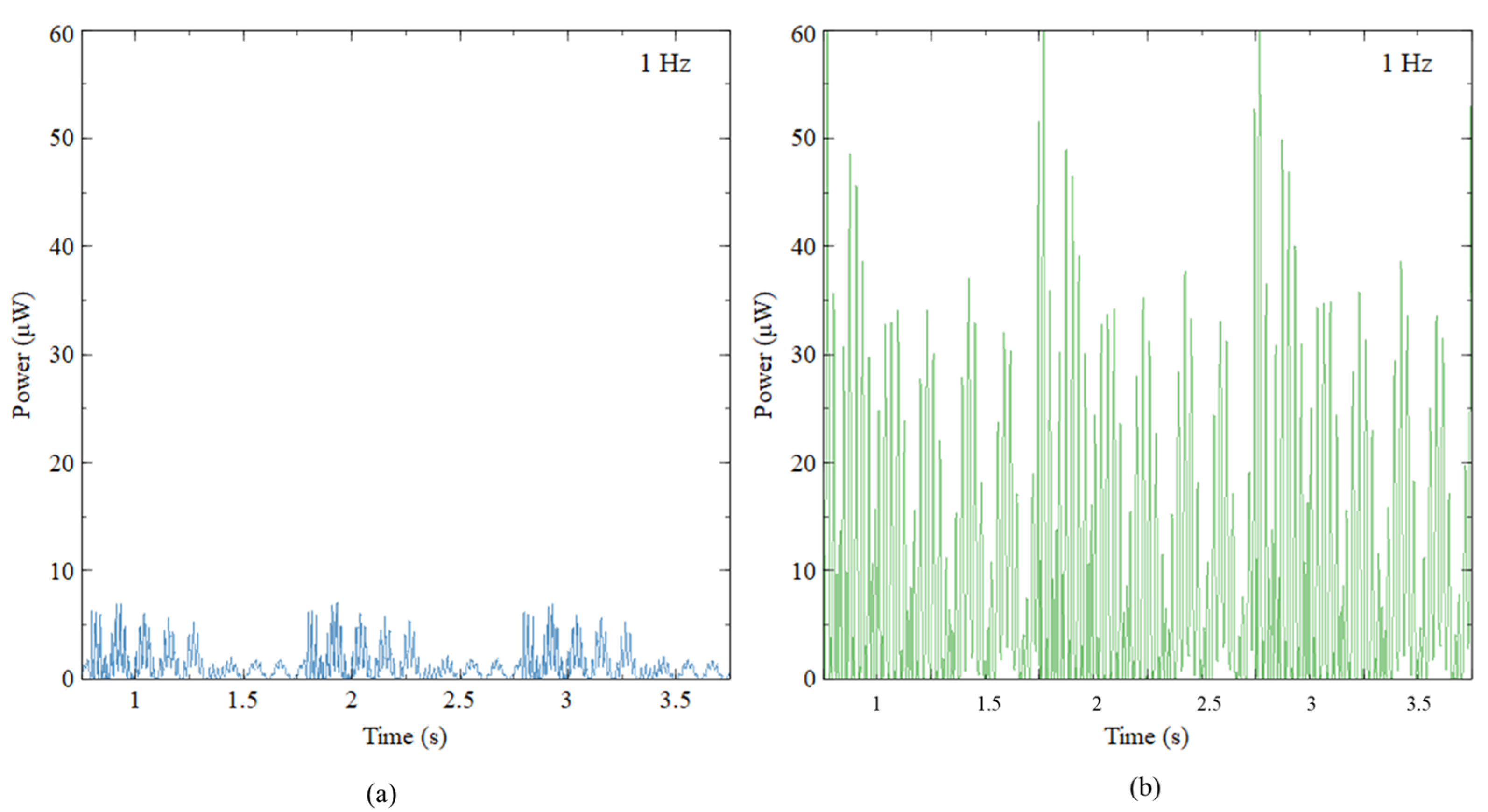




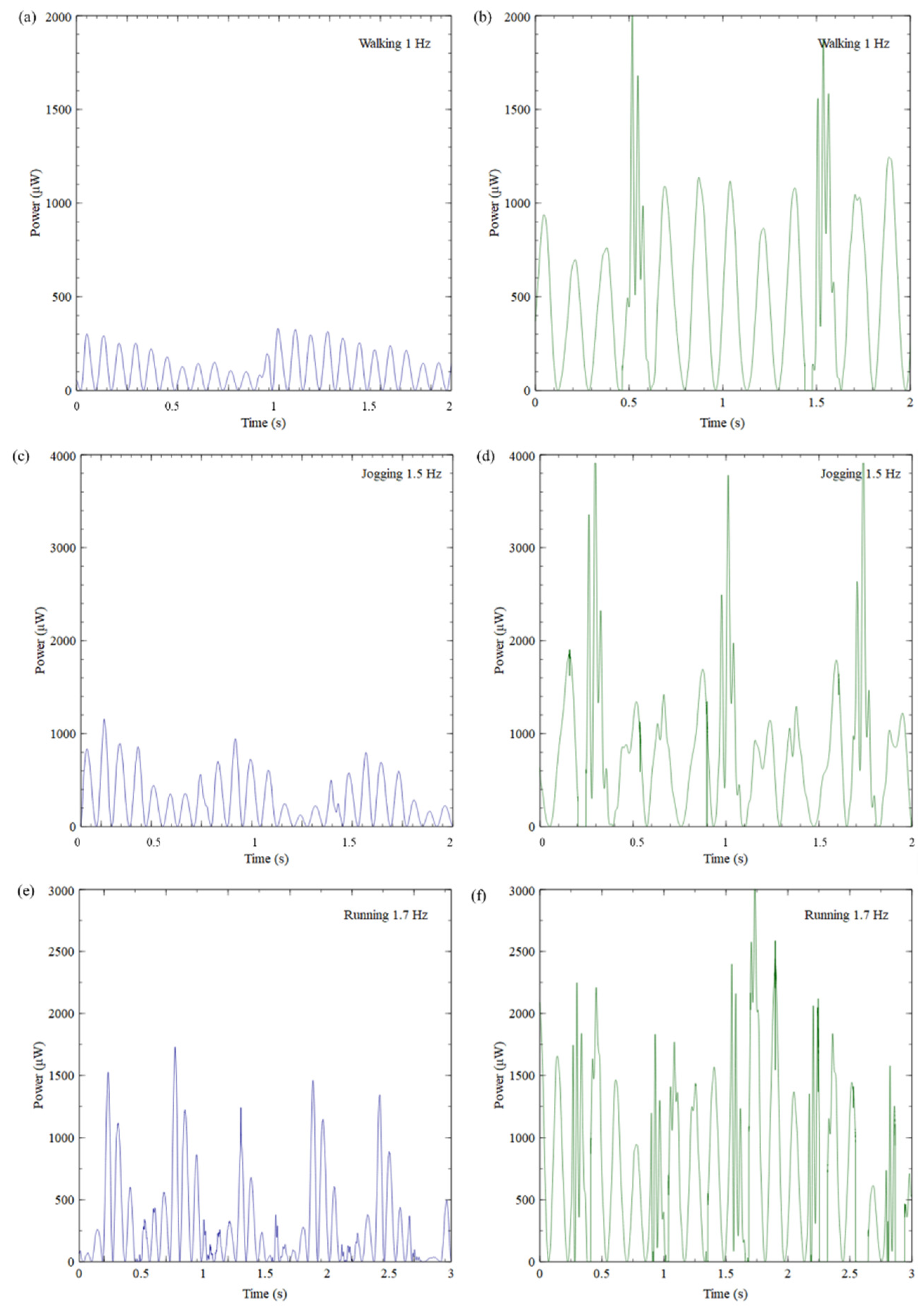

| Parameters | Aluminium Beam | Proof Mass |
|---|---|---|
| Materials | Aerospace-graded Aluminium 2024 | Steel |
| Elastic modulus (GPa) | 70 | 210 |
| Poisson’s ratio | 0.33 | 0.28 |
| Density (kg/m3) | 2780 | 7900 |
| Property | Young’s Modulus E1 (GPa) | Young’s Modulus E2 (GPa) | Poisson’s Ratio V12 | Shear Modulus G12 (GPa) | Piezoelectric Charge Constants d33 (pC/N) | Piezoelectric Charge Constants d31 (pC/N) | Active Area Density (kg/m3) |
|---|---|---|---|---|---|---|---|
| Value | 30.336 | 15.857 | 0.31 | 5.515 | 4.6 × 102 | −2.1 × 102 | 5440 |
| Prototype | NF1 | NF2 | NF3 | NF4 | NF5 | NF6 |
|---|---|---|---|---|---|---|
| CBH | 4.6351 | 65.083 | 67.488 | 176.37 | 177.19 | 322.04 |
| SCBH | 2.1566 | 4.3539 | 15.729 | 24.140 | 36.280 | 82.220 |
| ASBBH | 1.4358 | 2.2514 | 2.8898 | 3.6123 | 5.5713 | 6.8565 |
| Type of Analysis | NF1 | NF2 | NF3 | NF4 | NF5 | NF6 |
|---|---|---|---|---|---|---|
| ASBBH (FEA Study) | 1.44 | 2.25 | 2.88 | 3.61 | 5.57 | 6.86 |
| ASBBH (Experimental Study) | 1.50 | 2.25 | 3.00 | 3.75 | 4.25 | 5.75 |
| Reference | Design Descriptions of the PEH | Types of Piezoelectric Materials | Frequency | Motion Type | Number of Natural Frequencies (NFs) < 10 Hz | Average Output Power | Remarks |
|---|---|---|---|---|---|---|---|
| Izadgoshasb, 2019 [27] | PEH with a double-pendulum system | MFC (M2814-P2) | 1 Hz | Walking | 1 NF | 36 μW | Total weight of the system ≈ 250 g |
| Jiang, 2021 [66] | V-shaped bent beam harvester | PZT-5H | 1 Hz | Feet stamping | None | 100 μW | Volume ≈ 8400 mm3 |
| Nastro, 2022 [67] | Wearable Ball-Impact PEH | PZT (RS-pro-285–784) | 4 Hz | Wrist rotations | N/A | 9.65 μW | Volume ≈ 8100 mm3 |
| Piyarathna, 2023 [32] | Bent branched beam PEH | MFC (M2814-P2) | 1 Hz | Walking | 3 NFs | 168 μW | Volume ≈ 8000 mm3 |
| Proposed ASBBH | Arc shaped branch beam harvester | MFC (M2814-P2) | 1 Hz | Walking | 6 NFs | 477 μW | Volume ≈ 5100 mm3 |
Disclaimer/Publisher’s Note: The statements, opinions and data contained in all publications are solely those of the individual author(s) and contributor(s) and not of MDPI and/or the editor(s). MDPI and/or the editor(s) disclaim responsibility for any injury to people or property resulting from any ideas, methods, instructions or products referred to in the content. |
© 2023 by the authors. Licensee MDPI, Basel, Switzerland. This article is an open access article distributed under the terms and conditions of the Creative Commons Attribution (CC BY) license (https://creativecommons.org/licenses/by/4.0/).
Share and Cite
Piyarathna, I.E.; Thabet, A.M.; Ucgul, M.; Lemckert, C.; Lim, Y.Y.; Tang, Z.S. Linear Segmented Arc-Shaped Piezoelectric Branch Beam Energy Harvester for Ultra-Low Frequency Vibrations. Sensors 2023, 23, 5257. https://doi.org/10.3390/s23115257
Piyarathna IE, Thabet AM, Ucgul M, Lemckert C, Lim YY, Tang ZS. Linear Segmented Arc-Shaped Piezoelectric Branch Beam Energy Harvester for Ultra-Low Frequency Vibrations. Sensors. 2023; 23(11):5257. https://doi.org/10.3390/s23115257
Chicago/Turabian StylePiyarathna, Iresha Erangani, Ahmed Mostafa Thabet, Mustafa Ucgul, Charles Lemckert, Yee Yan Lim, and Zi Sheng Tang. 2023. "Linear Segmented Arc-Shaped Piezoelectric Branch Beam Energy Harvester for Ultra-Low Frequency Vibrations" Sensors 23, no. 11: 5257. https://doi.org/10.3390/s23115257
APA StylePiyarathna, I. E., Thabet, A. M., Ucgul, M., Lemckert, C., Lim, Y. Y., & Tang, Z. S. (2023). Linear Segmented Arc-Shaped Piezoelectric Branch Beam Energy Harvester for Ultra-Low Frequency Vibrations. Sensors, 23(11), 5257. https://doi.org/10.3390/s23115257







